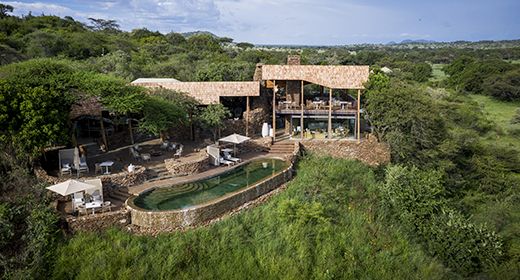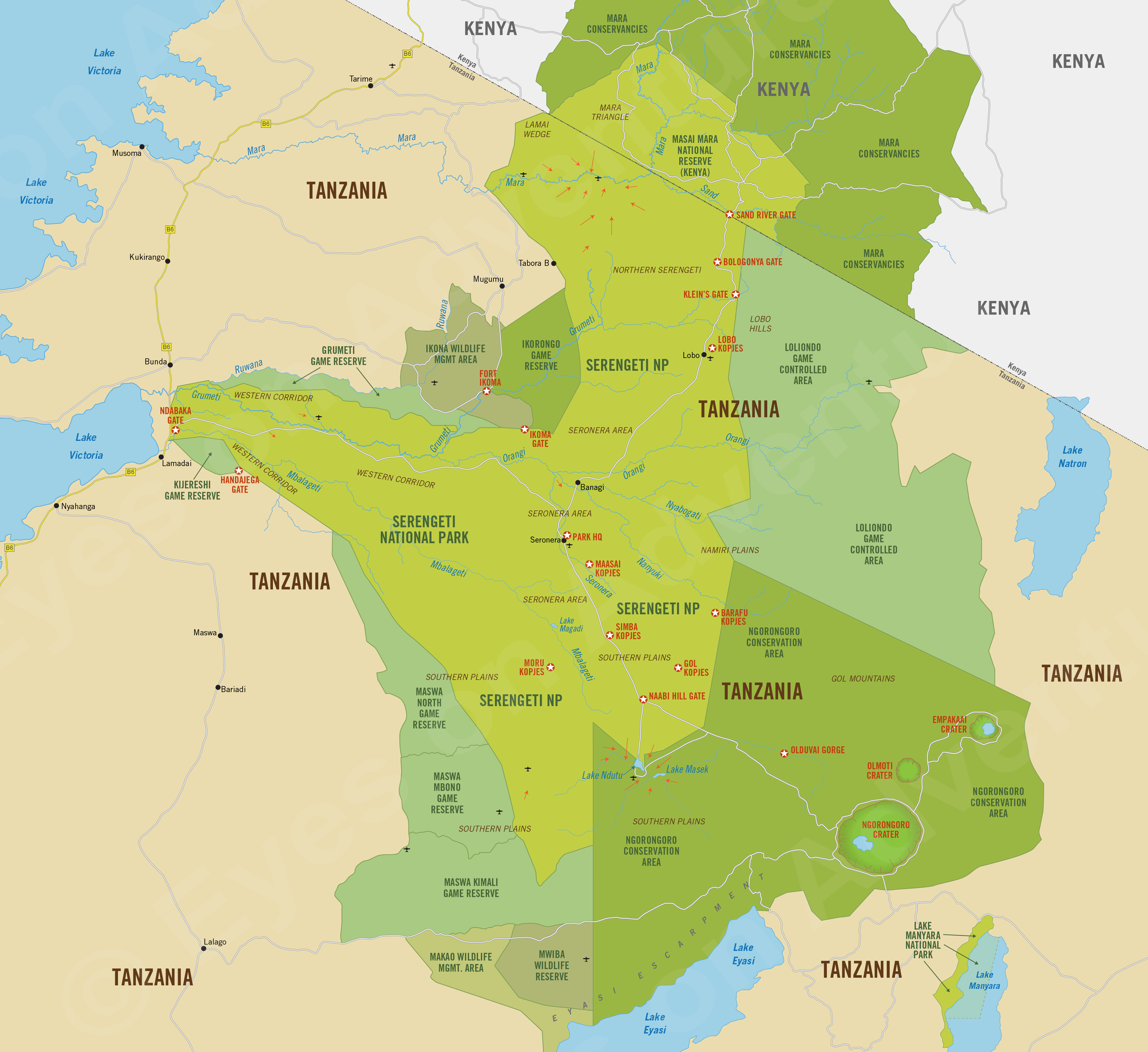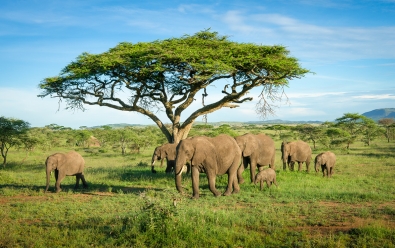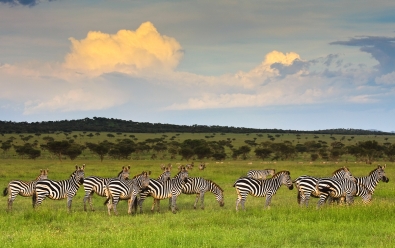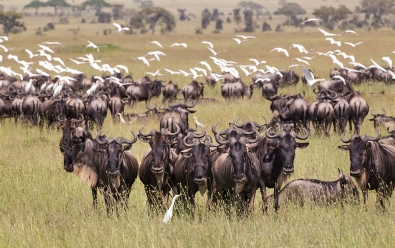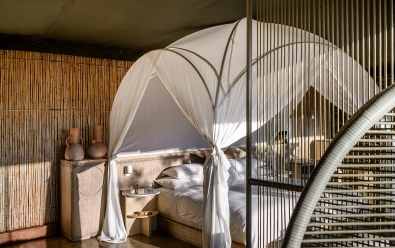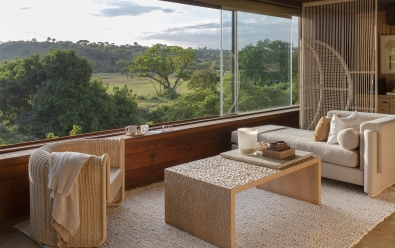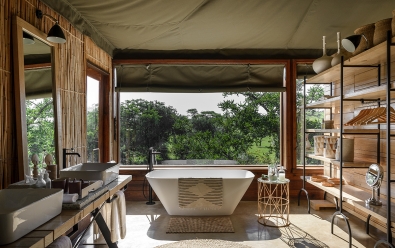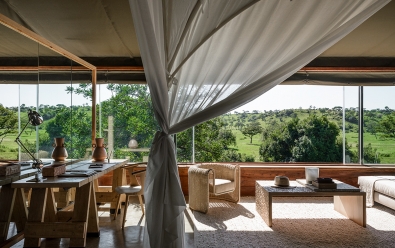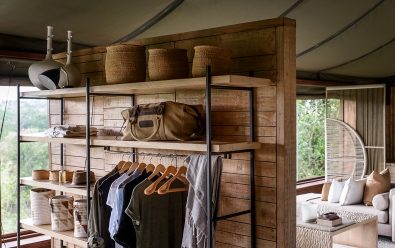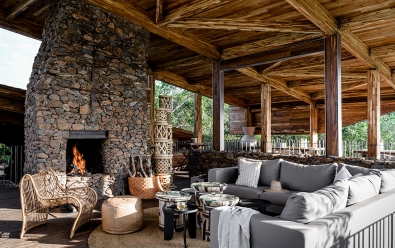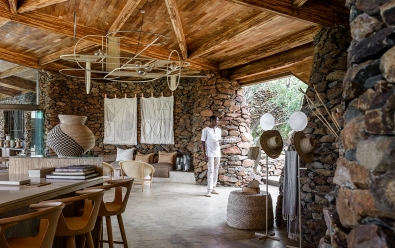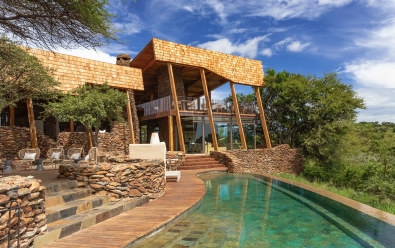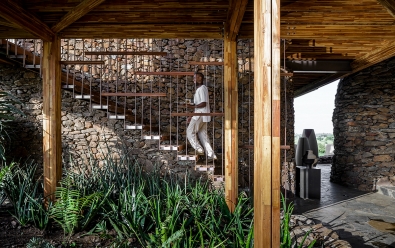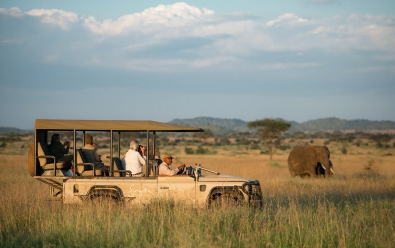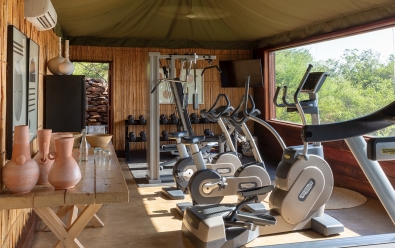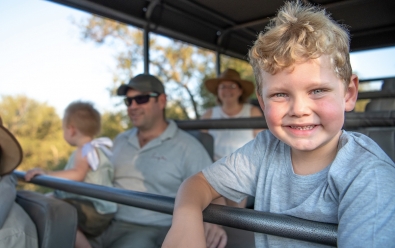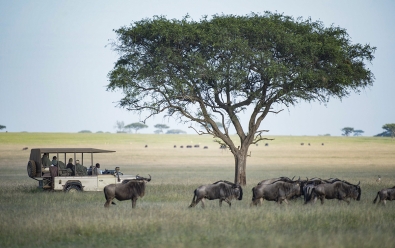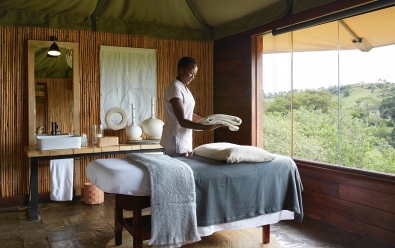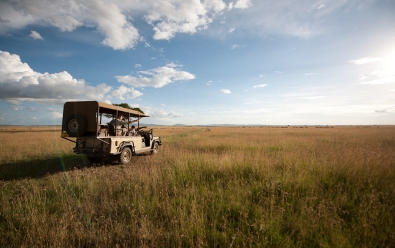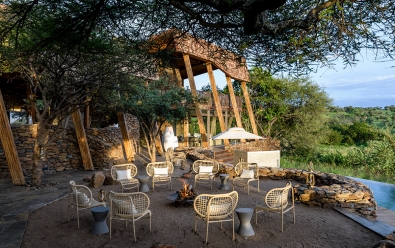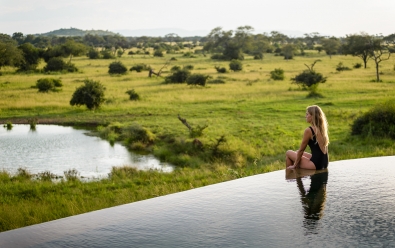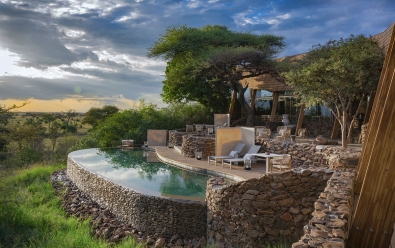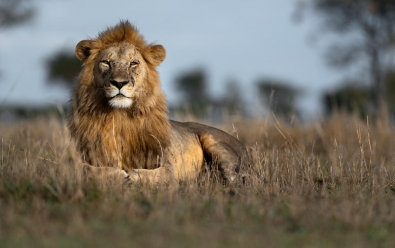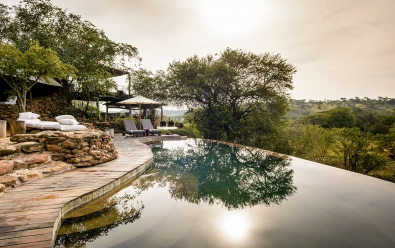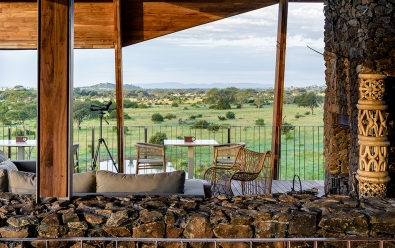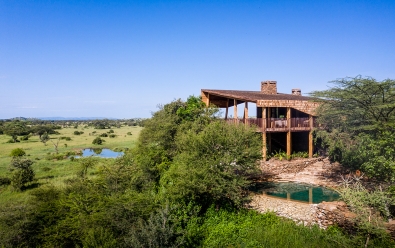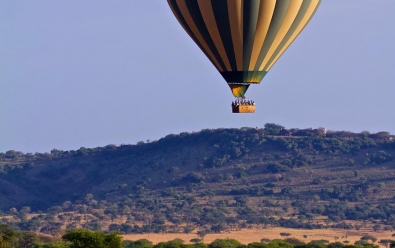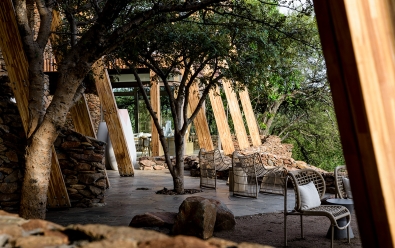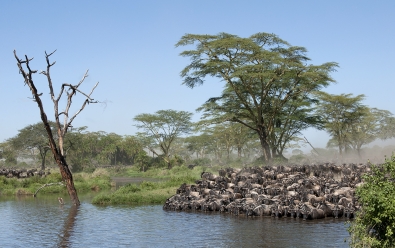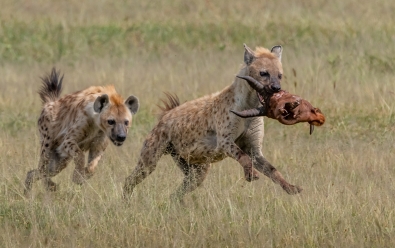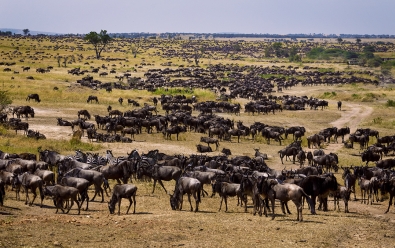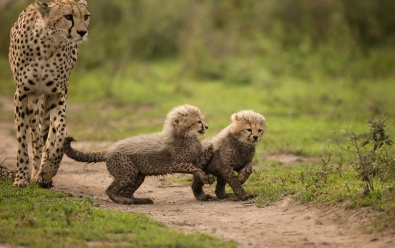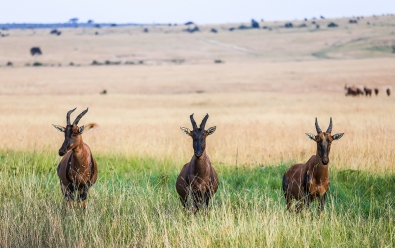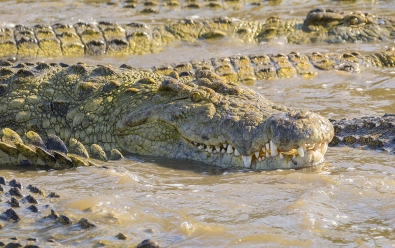Singita Faru Faru Lodge
Highlights
- On the Great Migration route (between May and July)
- One of the best safari destinations in East Africa
- Not subject to national park restrictions
- Low visitor numbers ensures an exclusive experience
Location
- Ikona Wildlife Management Area
- Greater Serengeti
- Northern Tanzania
Faru Faru Lodge is situated overlooking the Grumeti River and alongside a waterhole that is frequently visited by wildlife.
Singita Faru Faru Lodge is located in the Ikona Wildlife Area, which borders the northern side of the Serengeti National Park. The camp is ideally positioned on the route of the Great Migration of over two million herbivores and also offers excellent game viewing all year.
Activities offered at Faru Faru Lodge include morning and afternoon safari drives in the Grumeti and Ikona Reserves, walking safaris with a trained guide, hot-air balloon trips for eagle's-eye views over the Serengeti grasslands, and cultural interactions with the local Maasai people.
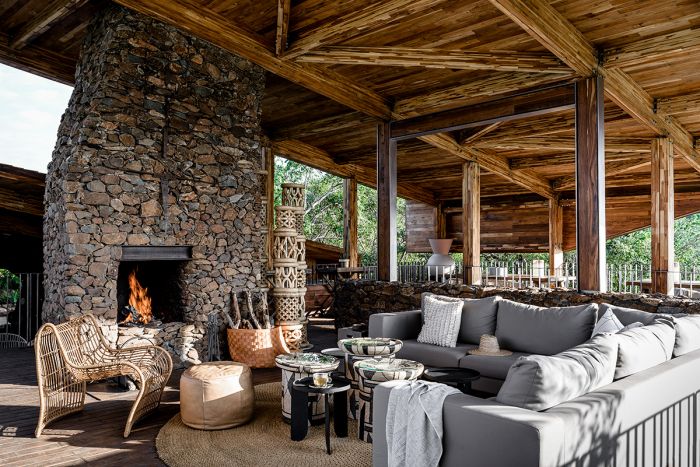
Lower level lounge and fireplace at Faru Faru Lodge.
Located on a gently sloping hill, Faru Faru is built in the style of a classic East African safari camp, with the suites and lodge areas decorated as a throwback to the timeless Colonial era. The lodge is a mix of contemporary, organic style and the quirky practicality of a traditional botanist’s camp. With such close proximity to the river and plains, guests have the unique opportunity to experience a very close connection with the wilderness.
Faru Faru offers 9 luxurious guests suites, one of which is a family suite that accommodates 2 adults and 2 children and another two-bedroom suites that accommodates 4 adults and has its own private pool.
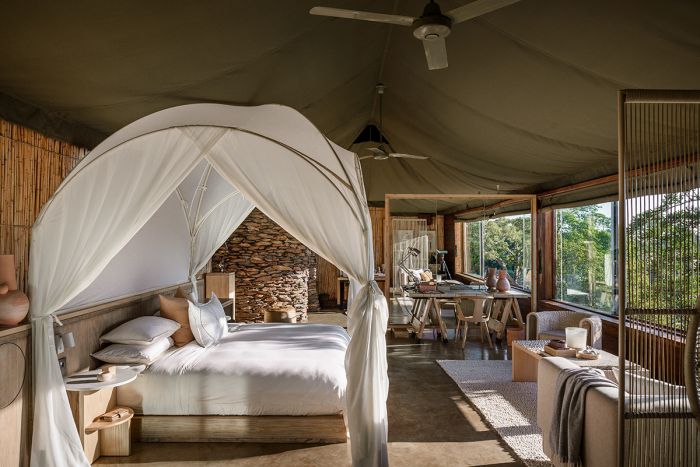
Guest suite bedroom at Singita Faru Faru.
The lodge's main guest area comprises a lounge, dining area, and café-style bar. Large outdoor decks provide plenty of views in all directions. Just outside the lodge are two swimming pools with decks and a popular campfire area. For those who want extra pampering, the Wellness Centre offers massages and beauty treatments and a fitness centre is available as well. Shopping is offered at the Singita Boutique and Gallery.
Singita are one of Africa's leading safari operators and they strive to minimize energy consumption at all their camps. Faru Faru Lodge is connected to the national grid with a backup generator available. Strict eco-friendly environmental standards are maintained so that no harmful chemicals or waste is allowed to enter the pristine ecosystem of the Serengeti.
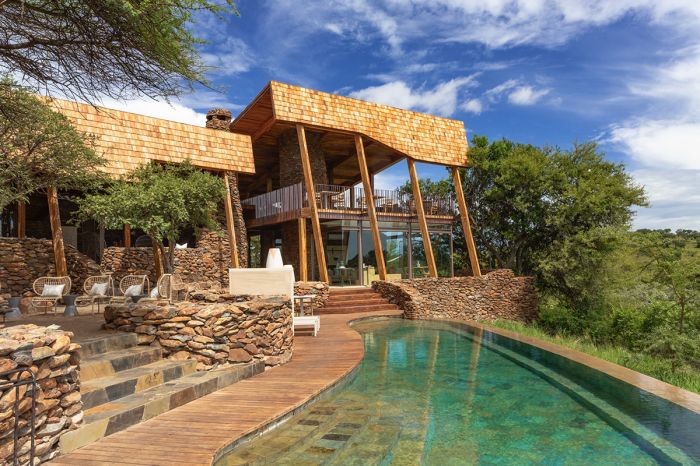
Main area and pool at Faru Faru Lodge.
About the Serengeti
The Greater Serengeti is part of an extensive ecosystem that includes Serengeti National Park, the Ngorongoro Conservation Area, and other reserves, wildlife management areas, and game controlled areas.
The Greater Masai Mara (directly to the north in Kenya) includes the Masai Mara National Reserve, as well as numerous private Mara conservancies. Together, the combined Greater Serengeti-Mara ecosystem, which combines the areas described above, covers roughly 15 000 square miles (39 000 sq kms).
The Serengeti-Mara is home to a very large number and diversity of wild animals and is also the location of the well-known "Great Migration" of over 2 million herbivores (read more below). This is arguably Africa's greatest overall wildlife destination.
Wildlife densities in the Greater Serengeti are some of the highest in Africa, with commonly seen herbivores including blue wildebeest, plains zebra, Thomson's gazelle, topi, Grant's gazelle, hartebeest, giraffe, elephant, buffalo, impala, waterbuck, bushbuck, warthog, and many others. Predators seen often include lion, leopard, spotted hyena, cheetah, serval, and jackal. Hippo and crocodile are found in large numbers in the larger rivers, including the Mara River and the Grumeti River.
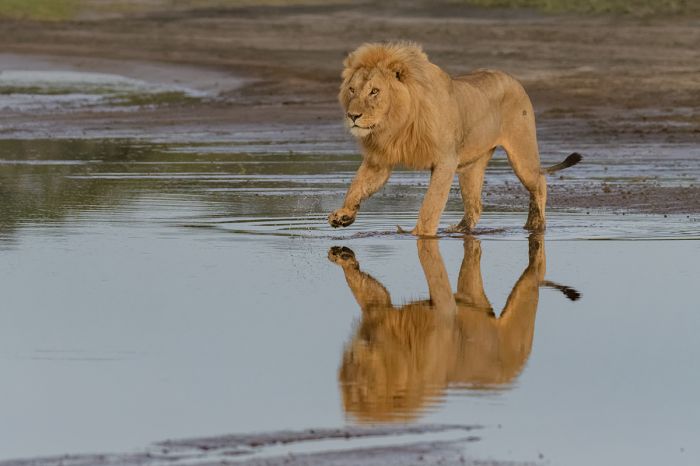
A male lion in the Southern Serengeti at Lake Ndutu.
ABOUT THE GRUMETI GAME RESERVE
The Grumeti Game Reserve was created by the Tanzanian government in 1994 in order to protect the path of the annual wildebeest migration and the indigenous biodiversity of this vast and important ecosystem. In 2002, the Grumeti Community and Wildlife Conservation Fund, a not-for-profit organization, was granted the right to manage and conserve these 350 000 acres for the benefit of Tanzania, Africa and the world.
Four years later, Singita took over the management of the property, at the request of the concessionaire and began the task of generating, via low-impact tourism, the funds necessary to ensure the long-term sustainability of the reserve through conservation and community partnership.
Ikona Wildlife Management Area
Bordering the Grumeti Reserve on its northeast is the Ikona Wildlife Management Area. Ikona was established in 2007 as a "mixed-use" area and is managed by the local Maasai community.
Singita leases land in Ikona and has built three lodges there (Sasakwa, Faru Faru, and Singita House). Ikona covers 94 square miles (243 sq kms) of prime safari territory and guests at any of the Singita camps in both Grumeti and Ikona can access both reserves for game drives.
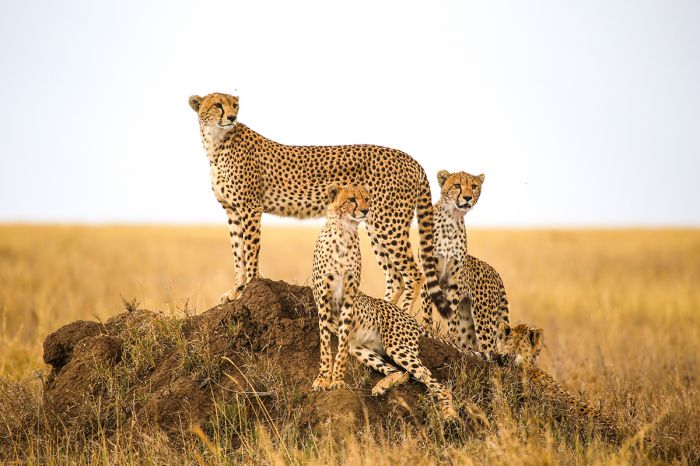
The Serengeti is one of the best destinations to see cheetahs.
The Great Migration
One of nature's greatest living spectacles is the Great Migration, a term given to describe the year-long, circular, clockwise march of over two million herbivores across the Serengeti and Masai Mara grasslands. The migration animals are made up entirely of two species: the blue wildebeest and the plains zebra (the majority of which are wildebeests).
The migrating herds follow their instincts to seek out fresh grazing and so the migration is ongoing, with the herds ever moving and taking a full year to complete a cycle across the Serengeti and Masai Mara. The animals move not as one herd, but as tens of thousands of animals in multiple herds of various sizes and spread out for many miles as they move.
The wildebeests and zebras take advantage of strongly seasonal conditions, spending the wet season (November through May) on the plains of Tanzania's Serengeti and the dry season in Kenya's Masai Mara. The wildebeests give birth between January and March on the short grass plains in the southern Serengeti.
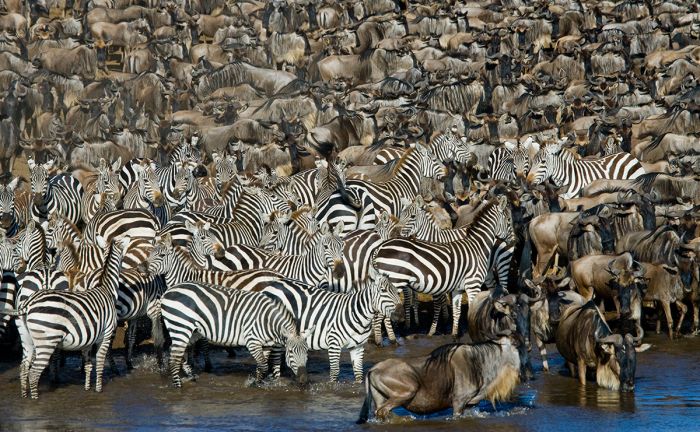
The Great Migration of wildebeests and zebras.
The timing of the migration is rarely ever the same year-to-year, as local conditions influence grass growth and as such, the location of the bulk of there animals cannot be known precisely. Rains and other unknown conditions seem to direct the timing of the migration, but generally, it is known within several weeks when the animals will be in a general location.
The animals spread out to cover a vast area, but the main bulk of the animals moves south into the northern Serengeti around late-October and continue moving south towards the Serengeti's southern plains, arriving there sometime in January to graze on the rich grass growing on the volcanic soils. It is here on these short-grass plains, between January and early March, when the wildebeests give birth to their young en masse, producing some 500 000 baby wildebeests.
The herds remain on the southern short-grass plains until late March, giving the young animals time to grow and become strong, before heading north and west again. Many of the animals move towards the Serengeti's Western Corridor and Grumeti Reserve and the rest straight north into Central and Northern Serengeti, where they remain during June and into July. The herds move back into Kenya starting in late July, with the bulk moving into the Masai Mara in August.

A long line of wildebeests during the Great Migration in the Serengeti.
Although many visitors time their visit to the Serengeti to coincide with the Migration, any region within the Serengeti offers very good wildlife viewing outside of the months when the migration may be present. This is because it is only the wildebeests and zebras that migrate, while the rest of the animals, including the major predators like lion, leopard, spotted hyena, and cheetah, as well as all the other herbivores, including springbok, gazelles, elephant, topi, hartebeest, and many others, do not migrate.
A popular aspect of experiencing the Great Migration is observing a herd as it crosses the Mara River, which requires animals swimming through waters inhabited by large Nile crocodiles that wait for a chance to get their first substantial meal in many months.
The dramatic river crossings (which take place along the Mara River in both Kenya and Tanzania) are certainly a spectacle and not for the faint of heart, with many of the wildebeest and zebras taken by crocs or succumbing to drowning or trampling in the chaos. The best chances for seeing a Grumeti River crossing is in June, while Mara River crossings are best in July and August.
ROOMS INCLUDES & EXCLUDES CHILDREN FACILITIES ACTIVITIES
ACCOMMODATION
9 guest accommodations in total comprising:
- 7 1-bedroom suites.
- 1 family suite (2 adults and 2 children).
- 1 2-bedroom suite (4 adults) with a private pool.
Each suite includes en-suite bathrooms with an indoor bathtub, outdoor shower, double-basin vanity, and separate toilet.
The family suite has a master bedroom (can be double or twin beds) and a second bedroom that can only accommodate children. The master bathroom includes an indoor bathtub, outdoor shower, double-basin vanity, and separate toilet. The smaller children's bathroom has an outside bath and shower. The rooms are not inter-leading, but separated by a small passage, each with its own entrance. The rooms share an outside deck area.
The two-bedroom suite is comprised of two regular suites that are river facing and can be made into either a double or twin. They share a central lounge and spacious deck and both have en-suite bathroom with inside bath, outside shower, and a private plunge pool. The unit is under one big canvas roof with stone walls.
The guest tents are connected to the main camp area by footpaths on the ground.
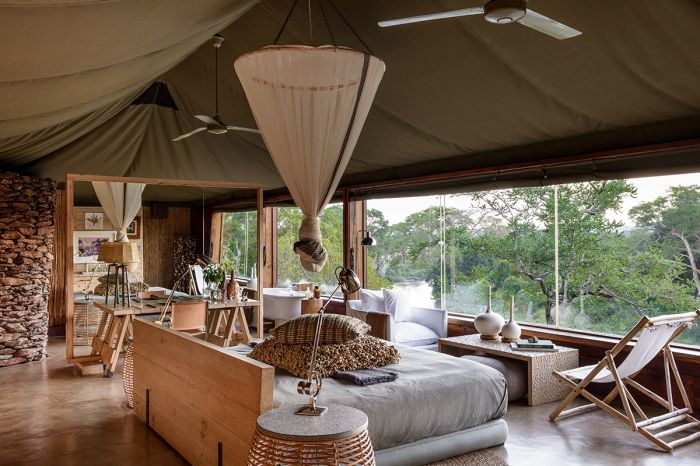
Guest suite bedroom at Faru Faru Lodge.
All the suites are airy and full of contemporary luxury and creature comforts. Oversized windows offer sweeping views and welcome in the surrounding wilderness.
Other items and features in the guest suites include:
- Air-conditioning.
- Overhead fans.
- Minibar and fridge.
- Tea and coffee station.
- Digital safe.
- Hairdryer.
- Mosquito netting over the bed.
- Bathroom amenities.
- In-room Wi-Fi.
- Direct-dial telephone.
- Small game-viewing deck.
Faru Faru Lodge can accommodate a maximum of 22 guests in total: 2 persons in each of the 7 standard suites and 4 persons each in the two double suites.
Includes & Excludes
Includes:
- All meals and beverages (including premium wines, spirits and liqueurs, but excluding French Champagne).
- Twice-daily game drives in open game-viewing vehicles.
- Return road transfers between the Sasakwa airstrip and the lodge.
- Laundry service.
- Wi-Fi access. There is complimentary internet (Wi-Fi) access; however, due to the remote location of the lodge, the wireless connection can be slow and intermittent.
Excludes:
- Wildlife fee, park fee, concession fee, tourism development levy.
- Carbon offset levy.
- Purchases from the Singita Boutique & Gallery.
- French Champagne.
- Massage treatments.
- Any additional activities not mentioned above.
- Transport to and from other safari camps.
- Any applicable wildlife fee, park fee, reserve fee, concession fee, other land-use fee.
Single Supplement
A single supplement may apply for any room booked by a single traveler; please ask us for pricing.
Children
Children of all ages are welcome at Singita Faru Faru Lodge.
Encountering Africa’s magnificent wildlife is a truly life-changing experience, no matter what one’s age, and time spent at Singita Faru Faru Lodge makes for an unforgettable family holiday. Filled with discovery and shared connections within nature, it’s an ideal opportunity to open children’s eyes to the wonders of an untouched wilderness.
All activities at the lodge are tailored to specifically suit the interests of each family. In the interest of safety, children may participate in game drives and bush walks at the discretion of dedicated Field Guides. The lodge also offers child-minding services as well as an array of activities to keep little ones engaged and entertained.
Singita's exciting Mini Rangers Course is a customized, fun-filled program that opens up a whole new world to young explorers. It includes learning how to track animals, astronomy, bush survival techniques, animal-, tree-, and bird-spotting competitions, as well as nature quizzes.
More children’s activities offered:
- Cooking interactions.
- Board games.
- Stargazing.
- Bush walks (minimum age 16).
- Activity booklets with a variety of games, quizzes and games.
- Arts & Crafts.
- Swimming.
- Movies.
FACILITIES
Large outdoor decks on two levels offer views in all directions and include plenty of private enclaves for intimate drinks or dining. The café-style bar is located in the heart of the lodge and leads to the main pool and the outdoor camp fire area.
Other main guest area facilities include:
- Two swimming pools.
- Wellness and Fitness Centre facilities.
- Singita Boutique & Gallery.
- There is a television in the lounge.
- This area does not have mobile phone signal.
- There is complimentary internet (WiFi) access; however, due to the remote location of the lodge, the wireless connection can be slow and intermittent.
- Electricity/power available: 220V. Converters are available and hair dryers are supplied in each suite.
- Halaal food is available, please book in advance.
Activities
Singita Grumeti Reserves form part of the world-famous migratory route. The absence of fencing allows the migration of game between the park and the concession. The reserve is home to varying habitats including open plains, rugged rocky outcrops, woodlands and riverine forests.
The Great Migration traditionally moves through Grumeti and Ikona between June and August. However, there is an abundance of wildlife to be seen in in this area throughout the year, including 400 species of birds, 40 species of herbivores, 25 species of large carnivores, and abundant and diverse plant life and floral species.
Activities included in the rate:
- Twice-daily game drives (staying out past sunset is allowable) in open 4x4 Land Cruisers (4 guests per vehicle).
- Guided nature walks.
- Archery.
- Lawn croquet.
- Badminton.
- Billiards.
- Star gazing.
- Mountain biking.
- Birding.
Optional activities at additional cost:
- Private activities are on offer (subject to vehicle availability which needs to be booked in advance).
- Hot-air ballooning.
- Community visit to a Maasai village.
- Wellness treatments.
Example of a typical day:
- Early morning wake-up call. Morning wake-up and activity times vary according to the seasons, activities on offer, and wildlife sightings.
- Light breakfast before departing on the morning activity.
- Return to the lodge for a meal and rest period.
- Meet for afternoon tea and snacks (savory and sweet choices) before departing on the activity.
- Return to camp - freshen up or meet for drinks, followed by dinner.
- Enjoy a nightcap and/or discussion at the bar or around the campfire before retiring.
Great Good Fair Poor
- Jan
- Feb
- Mar
- Apr
- May
- Jun
- Jul
- Aug
- Sep
- Oct
- Nov
- Dec
General Tips
It is advised to avoid the Serengeti over March and April, when heavy rains typically occur. June to mid-October is excellent for general game viewing. The large herds of animals in the Great Migration usually cross into the Serengeti from Kenya's Masai Mara sometime around early October and move north back into Kenya around mid- to late-July.
Besides the Great Migration, the other big factor that impacts a stay in the Serengeti is rains. The region experiences most of its rain between November and May, but there are two somewhat distinct rain seasons, the 'short' rains and the 'long' rains (read more below).
Singita Faru Faru is open year-round.
Rains
Short Rains
The short rains occur for about one month sometime during November and December (the exact time varied somewhat year to year). This period is called the 'short' rains because the duration of an individual rain event is short and it is rare to have an all-day rain event. Most rain falls as an afternoon shower, while mornings are typically overcast or clear.
Long Rains
The long rains occur between March and May, with April being the wettest month of the year. During this tome, rain should be expected almost every day and the showers can last for hours at a time, although all-day rain is not typical. The roads in the Serengeti become muddy and very difficult in places, which can hamper game drives. Cloudy skies are typical and temperatures can be chilly at times.
The period between the short and long rains (January and February) also receives rain, but many days are clear and the amount and duration of the rain events is unpredictable, with some afternoon showers and the odd long and heavy rainfall event.
Temperatures
The temperatures in the Greater Serengeti do not experience wide fluctuation throughout the year, as the region lies between one and three degrees south of the equator. In general, daytime temperatures are comfortably warm and overnights and early mornings are chilly. Bring a fleece and rain jacket regardless of the timing of your visit.
Dry Season
The dry season (June to October) is sunny and warm most days and rarely hot. Rare rain showers can occur but are unlikely. From June thru August, the afternoon temperature averages 76-78°F (24-25°C), but some days can be warmer. Evenings and early mornings temperatures are often chilly, averaging 53-55°F (12-13°C).
September and October days are very pleasant, with temperatures averaging 80-83°F (28-30°C), with cool mornings persisting, averaging 53-56°F (11-13°C).
Rainy Season
The rain season is November through May (read more above) and the temperatures are fairly static throughout the season. Daytime temperatures average 79-83°F (26-28°C) and nighttime and early morning temperatures are chilly, but slightly warmer than the dry season, averaging 54-57°F (12-14°C)
The Great Migration
The annual movement of wildebeest and zebras across the Serengeti-Mara ecosystem is one of the greatest spectacles in the natural world. These large herds move in a circular track across southern Kenya and northern Tanzania, taking a full year to complete their cycle. The migration moves across both the Greater Masai Mara (in Kenya) and the Greater Serengeti (in Tanzania) in a fairly consistent pattern and timeframe. The animals move to take advantage of fresh grasses on which to graze.
The migrating herds of roughly 1.5 million blue wildebeests and several hundred thousand plains zebras spend about nine months of the year moving through Tanzania's Greater Serengeti and the other three months in Kenya's Greater Masai Mara. The migrating herds are in Tanzania's Greater Serengeti from sometime in October until around late-July (note that the timing is never precise and varies somewhat year to year). Note that the Serengeti is vast, and it is important to note where in the region the herds are located during this nine-month timeframe.
The animals spread out to cover a vast area, but the main bulk of the animals moves south into the northern Serengeti around late-October and continue moving south towards the Serengeti's southern plains, arriving there sometime in January to graze on the rich grass growing on the volcanic soils. It is here on these short-grass plains, between January and early March, when the wildebeests give birth to their young en masse, producing some 500 000 baby wildebeests.
The herds remain on the southern short-grass plains until late March, giving the young animals time to grow and become strong, before heading north and west again. Many of the animals move towards the Serengeti's Western Corridor and Grumeti Reserve and the rest straight north into Central and Northern Serengeti, where they remain during June and into July. The herds move back into Kenya starting in late July, with the bulk moving into the Masai Mara in August.
The migration is rarely ever the same in terms of precise timing and direction, as local rains and other conditions influence grass growth. The wildebeest may, therefore, move off the open plains earlier in some years and remain in the northern Serengeti for longer in others. Nonetheless, the best months for seeing the migration in the Southern Serengeti are in February and March, when the herds are adding new babies, in the Central Serengeti during May and June, when the herds are the most concentrated, and in the Western Corridor, Grumeti, and far Northern Serengeti from June thru August.
Many visitors hope to witness dramatic river crossings, when hungry crocodiles attack the herds as they swim across the dangerous rivers of the Northern Serengeti. Like the migration in general, the precise timing of the river crossings is never known from year to year, but crossings on the Grumeti River are usually best in June, while Mara River crossings are best in July and August.




